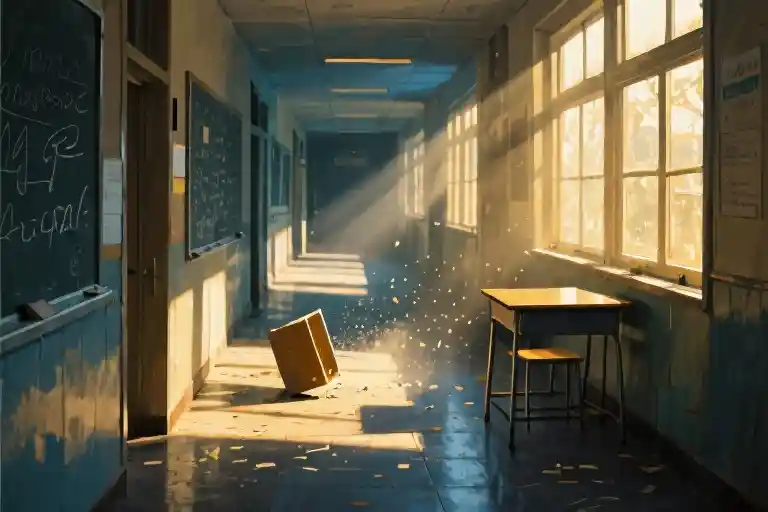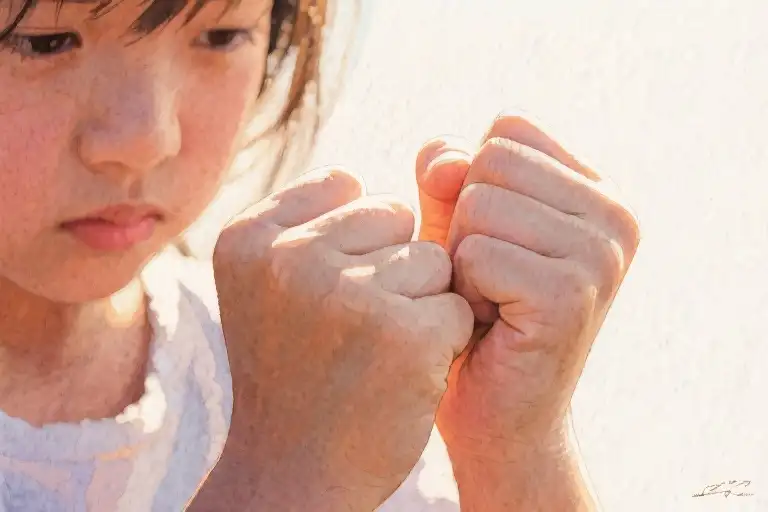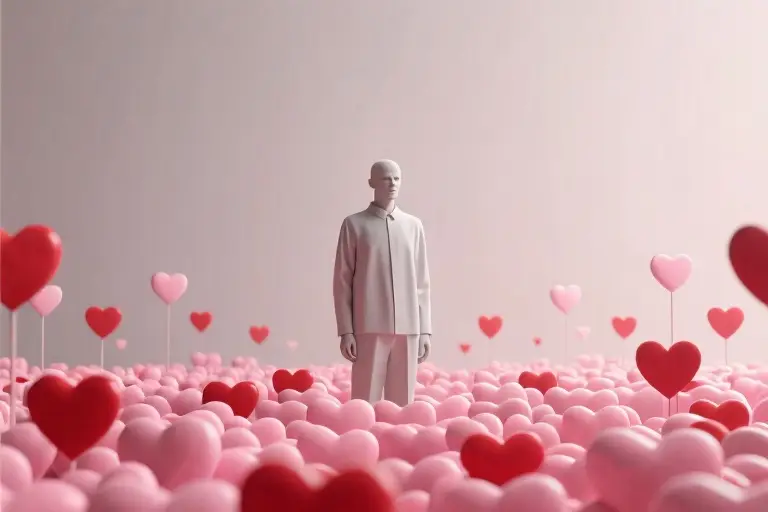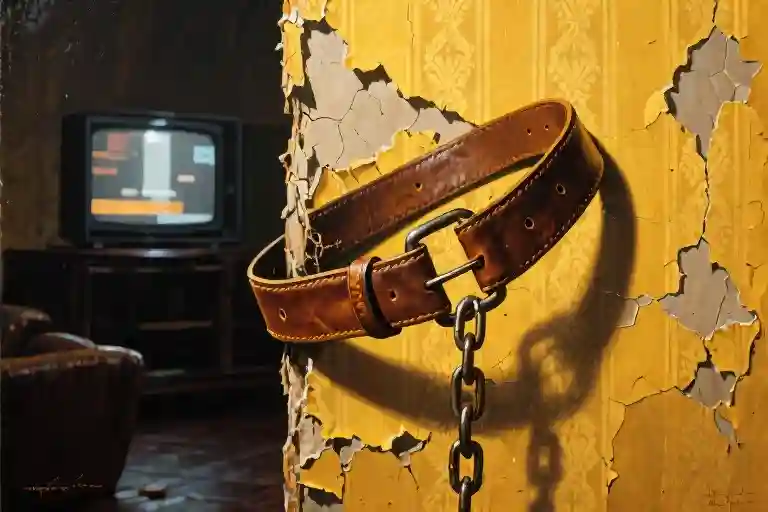The chalk dust hung suspended in shafts of afternoon sunlight as I pressed my back against the cold classroom wall. I was eight when I first heard it—that question that would echo through my adolescence like a distorted refrain.
‘What’s wrong with you?’ My teacher’s voice carried across the silent classroom, her eyebrows arched not at the boy who’d just shoved me into the bookshelf, but at me—the one with scraped elbows and tear-streaked cheeks. The injustice of it vibrated in my clenched fists, my racing heart counting seconds until the bell would free me.
Children’s playground politics should have been simple: he pushed, I pushed back. No blood, no broken bones—just the universal language of childhood conflicts. Yet in that moment, I learned society’s cruel grammar: when you stand up against bullying, you become the problem to be solved. The real question thrumming beneath my teacher’s words wasn’t about my actions—it was about my audacity to exist as anything but a perfect victim.
That fluorescent-lit classroom became my first courtroom. The verdict? Defending myself was my original sin. As other students avoided my eyes (some with guilt, others with relief it wasn’t them), I tasted the metallic fear that silences so many of us—the fear that next time, staying quiet might hurt less than speaking up.
Why does protecting yourself become the wrong answer? The question coiled around my ribcage for years, tightening each time I swallowed my anger. It’s the same question millions of girls whisper when dress codes target their shoulders instead of their harassers, when ‘boys will be boys’ excuses hands that steal personal space. That eight-year-old’s confusion never really leaves—it just grows up alongside us, waiting for the moment we’ll finally understand we were never the ones who needed fixing.
The First Accusation: Childhood Silence
The classroom smelled of chalk dust and childhood sweat, the kind of scent that lingers in elementary schools across the world. I remember how the afternoon light slanted through the windows, illuminating floating particles that seemed suspended in time—much like my eight-year-old self, frozen in that moment when everything changed.
His shove came first, sudden and hard against my shoulder. Then the names—words sharper than they had any right to be coming from a fourth grader’s mouth. When my eyes stung with tears, his laughter followed, bright and cruel. So I pushed back. Just once. Just enough to make him stumble.
That’s when Mrs. Henderson’s voice cut through the noise: “What’s wrong with you?” Her tone held the particular blend of disappointment and bewilderment adults reserve for children who disrupt the natural order—the order where victims stay victimized.
I stood there, small fists clenched so tight my nails left crescent moons on my palms. My heartbeat thundered in my ears, drowning out the classroom sounds. The question wasn’t for the boy who started it; it was for me, the one who dared to respond. In that suspended moment, I learned my first lesson about power: Sometimes defending yourself becomes the original sin.
The Unspoken Rules
- The Bully’s Advantage: His actions were expected, almost normalized (“boys will be boys”), while my reaction became the transgression
- The Adult’s Gaze: Teachers often focus on stopping conflicts rather than examining their roots—especially when the roots involve uncomfortable truths about power dynamics
- The Body Remembers: Even now, I can recall the physical sensations—the heat in my cheeks, the tremor in my hands—more clearly than the actual words spoken
“Nobody was hurt,” I wanted to say. Not really. Not in any way that would show up on a nurse’s report. But the invisible bruises—those didn’t count. The rules were clear: Take the hits quietly, or become the problem yourself.
That afternoon, walking home with my backpack straps cutting into my shoulders, I made my first vow of silence. It wouldn’t be my last—but it would be the one that shaped all the others. The next time someone asked “What’s wrong with you?” I’d be thirteen, on a crowded bus, with a stranger’s hand where it didn’t belong. And that time, against all my training, I’d finally answer.
The Second Awakening: Finding My Voice at Thirteen
The air inside the bus was thick with the mingled scents of diesel fuel, stale sweat, and cheap cologne. I remember gripping the metal pole so tightly my knuckles turned white, the vibrations of the moving vehicle traveling up my arm. That’s when I felt it – the slow, deliberate pressure of a hand sliding beneath my school skirt.
For a moment, time seemed to stop. My lungs constricted as if someone had punched me in the stomach. The chatter of other passengers faded into white noise, replaced by the deafening thud of my own heartbeat. That familiar question from childhood echoed in my mind: What’s wrong with you? But this time, something shifted.
The 0.5 Second Revolution
What happened next unfolded in fragments:
- Touch: The rough texture of a stranger’s fingers against my thigh (like sandpaper on raw skin)
- Sound: My own sharp intake of breath (the prelude to a scream)
- Action: My body twisting away before my mind could process the danger
- Voice: A single syllable tearing through the bus – “HEY!” – so loud it startled even me
The entire sequence took less than a second, but it changed everything. As I wrenched his hand away, I saw the exact moment power dynamics flipped:
- His widened eyes (pupils dilating with shock)
- The immediate retreat (shoulders hunching like a scolded child)
- The frantic glance around (assessing potential witnesses)
The Crowd Effect
What surprised me most wasn’t my reaction – it was theirs. Three things happened simultaneously:
- A grandmotherly woman moved her shopping bag to create a protective barrier between us
- A college student started filming with his phone (this was before #MeToo went viral)
- The bus driver’s eyes locked onto ours in the rearview mirror
Their silent solidarity gave weight to my words when I spat out: “Don’t you dare touch me again.” The man stumbled toward the exit at the next stop, his earlier confidence evaporating under collective scrutiny.
Why This Time Was Different
At thirteen, I understood what eight-year-old me couldn’t:
- The lie in the question: “What’s wrong with you?” implies the victim holds responsibility
- The power of witnesses: Harassers rely on silence; daylight is their kryptonite
- The body keeps score: That stomach-twisting sensation? It’s your nervous system screaming danger – not shame
Looking back, I recognize this moment for what it was – not just resistance, but reclaiming. That sticky bus seat became the unlikely stage where I traded childhood paralysis for teenage defiance. And while part of me still wonders what might’ve happened if I’d stayed quiet, the louder part knows: sometimes the bravest thing you can do is make a scene.
Key Insight: Predators expect fear. What terrifies them is when their target becomes the threat.
Who Should Be Questioned? The Systemic Bias Against Victims
The Three Mechanisms of Victim Blaming
Victim blaming doesn’t happen by accident. It’s a well-oiled machine with three interlocking gears that keep turning:
- The Just-World Fallacy: The comforting but false belief that bad things only happen to people who ‘deserve’ it. Like when people ask, “What were you wearing?” instead of “Why did they think they could touch you?”
- Social Power Imbalance: Systems naturally protect those with more social capital. Teachers questioning the child who fought back rather than the instigator. Police doubting harassment reports from young women.
- Cognitive Dissonance: It’s easier to believe victims did something wrong than accept that safety is an illusion. That bus could have been any of us – and that’s terrifying.
By the Numbers: Society’s Distorted Reactions
- 72% of women who report harassment face questions about their behavior or clothing (WHO Global Report 2022)
- School bullying victims are 3x more likely to be punished when they defend themselves (UNICEF Education Study)
- Only 1 in 5 workplace harassment cases result in consequences for the perpetrator (ILO 2023 Data)
These aren’t just statistics – they’re mirrors reflecting how often we instinctively side with power structures rather than justice.
Case Studies: The Uneven Scales of Justice
School Scenario A:
- Bully: “He’s just being a boy” (No consequences)
- Victim: “Why did you provoke him?” (Detention)
Public Transportation Scenario B:
- Harasser: “It was crowded, just an accident” (Released)
- Victim: “Why didn’t you move seats?” (2-hour police interrogation)
This pattern repeats everywhere from playgrounds to courtrooms. The underlying message? The victim’s behavior is always up for debate; the perpetrator’s rarely is.
Breaking the Cycle
Recognizing these patterns is step one. Step two is actively reversing them:
- When someone shares harassment experiences, respond with “How can I support you?” not “Why didn’t you…?”
- Challenge assumptions (“Maybe we should ask why he thought that was acceptable”)
- Share resources like RAINN’s hotline (1-800-656-HOPE) instead of unsolicited advice
The system won’t change overnight. But each time we redirect questioning from victims to societal failures, we loosen one bolt in that machine of bias.
Breaking the Silence: Your Practical Toolkit
Three-Step Response to Public Harassment
- Prevention Awareness
- Body language matters: Stand with shoulders back, maintain steady eye contact. Predators often target those who appear vulnerable.
- Environmental scanning: Note emergency buttons on buses/trains, identify safe spaces like stores with visible staff.
- Pro tip: Carry a loud personal alarm (test monthly) – studies show 83% of assailants flee when activated.
- In-the-Moment Resistance
- Verbal scripts:
- Direct: “Remove your hand NOW. This is harassment.” (Loud, clear, repeat)
- Indirect (if unsafe): “Dad! I’m over here!” to attract bystanders
- Physical actions:
- Create distance (elbow block → step away → move toward groups)
- Document: Discreetly activate phone video (practice quick-draw recording)
- Remember: Your safety > evidence collection. Escalate only if conditions allow.
- Post-Event Documentation
- Evidence preservation:
- Write incident details within 24 hours (memory fades fast)
- Save transit CCTV footage requests (most systems auto-delete in 72hrs)
- Reporting channels:
- Public transport: Use operator apps with “Report Harassment” buttons
- Schools/workplaces: Email creates paper trail vs verbal reports
Global Support Resources
| Country | 24/7 Hotline | Online Chat | Legal Aid |
|---|---|---|---|
| USA | RAINN: 800-656-HOPE | rainn.org | Equal Rights Advocates |
| UK | Rape Crisis: 0808-802-9999 | rapecrisis.org.uk | Rights of Women |
| Canada | Assaulted Women’s Helpline: 866-863-0511 | awhl.org | LEAF |
| Australia | 1800RESPECT: 1800-737-732 | 1800respect.org.au | WLS Australia |
Tip: Bookmark these on your phone under “Emergency – Health” for quick access.
Legal Action Roadmap
graph LR
A[Incident Occurs] --> B{Immediate Safety?}
B -->|Yes| C[Preserve Evidence]
B -->|No| D[Get to Safe Location]
C --> E[Medical Exam if Assault]
D --> E
E --> F[File Police Report]
F --> G[Request Protective Order]
G --> H[Consult Specialized Lawyer]Key Notes:
- Sexual harassment laws vary:
- EU: Employers must investigate all complaints
- Japan: 2022 law mandates anti-harassment policies
- Statute of limitations:
- Childhood abuse: Many states now allow adult survivors to sue
For Allies: How to Help
When someone shares their story:
- Believe first: “That should never have happened to you” > “Are you sure?”
- Offer control: “Would you like help reporting this?” (Never pressure)
- Practical support:
- Accompany to police stations (secondary trauma is real)
- Research local trauma therapists (many offer sliding-scale fees)
You carry more power than they want you to know. That shout on the bus? The pushback against a bully? Those weren’t just moments – they were revolutions. Print this guide. Share it with that quiet girl in your math class. The tools exist now that we wished we’d had. Use them unapologetically.
What I Would Tell My 8-Year-Old Self Now
Standing here today, I wish I could reach back through time to that trembling little girl with clenched fists. I’d wrap her in a hug she couldn’t receive from anyone in that classroom and whisper three truths:
- Your voice matters more than their approval
That teacher’s question said everything about broken systems, nothing about your worth. When adults fail to protect, it’s their failure – not your burden to carry. - The anger you swallowed was your power
What felt like paralysis in that moment? That was your body preparing to roar. Thirteen-year-old you proved it when she shouted loud enough to shake a bus full of silent bystanders. - This won’t be the last time – but you’ll be ready
The world still asks “What’s wrong with you?” when women stand up. Now we answer together.
If You Need Help Today
Maybe you’re reading this with your own unspoken stories. Here’s what I’ve learned about breaking silences:
When shame whispers:
- Keep evidence (texts/emails/photos) even if you’re not ready to act
- Write down details while fresh: dates, locations, witnesses
When you’re ready to speak:
- Start with confidential hotlines (see resources below)
- Use scripted phrases when overwhelmed:
- “That question blames the wrong person”
- “I don’t owe anyone my trauma”
For allies listening:
- Replace “Why didn’t you…?” with “How can I support you now?”
- Interrupt victim-blaming language in real-time
Global Support Resources
(hover/tap for local contacts)
| Type | Organization | Immediate Help |
|---|---|---|
| 24/7 Crisis | RAINN | Text “HELLO” to 800656HOPE |
| Legal Aid | Equal Rights Advocates | Workplace harassment toolkit |
| Youth Support | StopBullying.gov | Anonymous reporting forms |
The next time someone implies there’s “something wrong” with how you survived? Remember:
“The wound is not your fault, but the healing can be your victory.”
Start small. Save this page. Tell one person. You’ve already begun.





